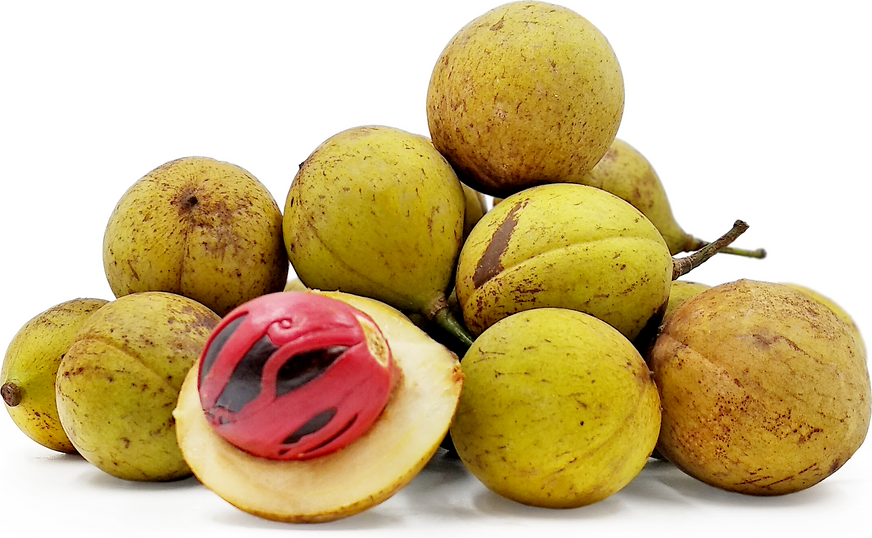


Pala Fruit
Estimated Inventory, lb : 0
Description/Taste
Pala fruits are small in size and are globose to oval in shape, similar in appearance to an apricot or small peach. The thin, mottled skin is pale green when young, maturing to bright yellow when ripe, and has a prominent seam that runs across the center of the fruit. As the fruit matures, this seam bursts open to reveal the flesh and seed. The flesh, also known as pulp, is cream-colored to pale yellow and is somewhat fibrous with an acidic, sour flavor. Within the flesh, a large, waxy, bright red aril covers the central dark brown pit in a lace-like pattern. This aril, when dried, has a light and delicate, warm flavor. Inside of the dark brown pit, there is an edible, oval seed that is similar in flavor to the aril but has a more pungent, spicy, and pronounced flavor.
Seasons/Availability
Pala fruit is available year-round in select tropical regions.
Current Facts
Pala fruits, botanically classified as Myristica fragrans, grow on large, tropical evergreen trees that can reach over twelve meters in height and belong to the Myristicaceae family. Also known as the Nutmeg fruit, Pala fruits are most well known for their seed and aril which are dried and made into the spices nutmeg and mace. Only cultivated in a few regions around the world and often overlooked as a fruit due to the spice’s popularity, Pala fruit is utilized in its entirety in Southeast Asia and the pulp is used to make jellies, candies, and drinks.
Nutritional Value
Pala fruit contains some potassium, manganese, copper, magnesium, and calcium.
Applications
The pulp of the Pala fruit is edible but is not typically consumed on its own as it has an extremely sour flavor. It is popularly blended into a juice and mixed with ginger, sugar, and lemon and served over ice as a refreshing drink. The pulp can also be sprinkled with salt, sugar, or chile and dried or crystallized to create a sweet treat or made into a syrup. The aril of the fruit, once dried, can be ground and made into the spice known as mace. This flavoring has a more delicate flavor than nutmeg and is sprinkled on vegetables, fish, and baked goods. Nutmeg, which is the dried seed, is the most utilized portion of the fruit and is used to flavor drinks such as lattes, rum cocktails, or cider, sprinkled over cooked spinach and other vegetables, used in baked goods, and mixed into béchamel sauce. Pala fruits will keep up to one week when stored in the refrigerator.
Ethnic/Cultural Info
While nutmeg and mace are spices that are known around the world, the flesh of the Pala fruit remains relatively unknown. The flesh is localized to the tropical regions where the fruit is grown and is not shipped globally with the seeds, diminishing its notoriety. Despite the fruit’s lack of publicity, Indonesian locals have been utilizing the flesh for additional culinary goods as a source of income. In Indonesia, the Pala fruit is cooked and crystallized to make manisan pala, which is a chewy, candied fruit. This candied fruit is sold to tourists and is also consumed on religious holidays and during New Year’s Eve celebrations. In addition to candied goods, Pala fruits are also commonly cooked into jams. In Indonesia, the jam is known as selei buah pala and is used to fill cakes or bread. Jams are also made on the island of Grenada in the Caribbean, where the jam is known as Morne Delice and is spread on toast, baked goods, and muffins.
Geography/History
Pala fruits are native to the Banda Islands, which are located in Eastern Indonesia and have been growing wild since ancient times. When the spices nutmeg and mace were created from the seed and aril of the fruit, they were easily transported on ships of explorers and in bags of merchants along trade routes and were introduced to Europe in the 11th century by Arab traders. These spices became extremely popular among the European upper class in the 15th century and were one of the most esteemed spices available. Nutmeg has caused many wars over the Banda Islands, and because of its popularity, Pala fruit seeds were smuggled and planted in Mauritius, Penang, India, and Sri Lanka to expand the spice market. Today Pala fruit trees are grown in the Caribbean on the island of Grenada, on the Banda Islands, in India, Malaysia, Mauritius, Indonesia, Sri Lanka, and in Papua New Guinea.















